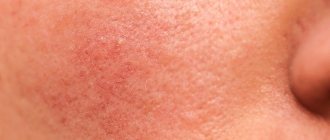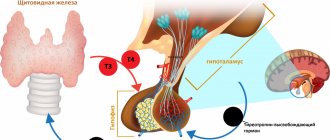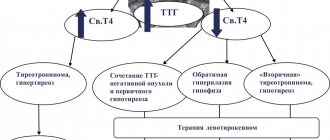Thyroid cancer
– a malignant tumor that develops from thyroid tissue, follicular cells or C-cells (parafollicular). Usually the first symptoms of the disease are swelling and nodes in the neck. Depending on the histological structure, different types of thyroid cancer are distinguished; they differ in varying degrees of aggressiveness and require different approaches to treatment. [1]
Usually, nodules in the thyroid gland are detected during an examination by an endocrinologist or ultrasound, sometimes they are discovered by patients themselves. Nodules can have different sizes, can be single or multiple, “hot” (accompanied by increased levels of hormones) and “cold”. Many patients immediately panic: is it probably cancer?
According to statistics, approximately every twentieth node turns out to be malignant.
. In most cases, this is not cancer, but conditions such as subacute thyroiditis (for example, due to influenza or mumps), Hashimoto's thyroiditis (autoimmune inflammation in the gland), and iodine deficiency.
- Symptoms
- Types of thyroid cancer
- Diagnosis in the early stages
- Stages of thyroid cancer
- Risk factors
- Treatment
- Prevention
- Rehabilitation therapy
- Life expectancy after surgery
- Consequences after surgery
- Life after thyroid cancer treatment
Symptoms
In addition to thyroid nodules, you need to pay attention to symptoms such as:
- swelling and pain in the neck;
- hoarse voice for more than three weeks;
- cough and sore throat;
- difficulty swallowing;
- enlarged lymph node in the neck;
- intestinal upset, facial redness (with medullary cancer).
In the early stages, thyroid cancer often has no symptoms. Regular examinations by an endocrinologist and ultrasound examination help to diagnose it in a timely manner.
Often a malignant tumor develops against the background of other pathological processes in the thyroid gland, such as nodular goiter, adenoma, autoimmune thyroiditis. Already existing nodes gradually increase in size, new ones appear, and their density increases. As metastases spread to regional lymph nodes, they also increase in size. Over time, the thyroid gland becomes so large that the neck becomes deformed.
Often the first symptom of the disease is an enlargement of the affected lymph node. A tumor in the thyroid gland is detected only by the results of a biopsy after its removal. This type of thyroid cancer is called latent.
In the later stages, when the tumor grows into the esophagus, trachea, compresses the recurrent laryngeal nerve, hoarseness of the voice, difficulty breathing, and coughing occur, during which sputum with blood is released. In such cases, the prognosis worsens.[1,4,5]
Thyroid cancer facts and figures:
- In general, the disease is quite rare: no more than 10–20 cases are diagnosed per 100,000 population per year, although rates can vary greatly in different countries.
- Thyroid cancer accounts for approximately 0.5–3% of all cancers.
- Women get sick approximately 2–3 times more often than men. But men usually have a worse prognosis.
- Unlike many other types of cancer, thyroid tumors often occur at a young age. For example, it is the most common type of cancer among women 20–35 years old. Every fiftieth patient is a child or teenager.
- According to American experts, in recent years the prevalence of the disease has been growing by about 5% per year. This is believed to be largely due to improved diagnosis. Doctors began to detect the disease more often.
- Thyroid cancer is relatively treatable. The average five-year survival rate is 98%. In later stages and in the absence of adequate treatment, the prognosis is greatly worsened.[1,2,6]
Book a consultation 24 hours a day
+7+7+78
Types of cancer
Oncologists distinguish four different types of thyroid cancer, which are characterized by specific symptoms and special treatment tactics:
- Papillary cancer . It accounts for up to 60% of all cases of oncology of this localization. Most often, this type of cancer occurs before the age of 40, and it predominantly affects women.
- Follicular carcinomas . They account for up to 15% of all types of oncology. Most often registered in old age.
- Medullary cancer . On average, it is registered in 5-8% of cases of thyroid cancer, has a familial nature, occurs at different ages and with equal frequency among women and men.
- Anaplastic form of cancer . The rarest of all types of oncology, has an aggressive course, usually registered after 60 years Source: A.A. Fedorov, E.L. Bederina, N.Yu. Orlinskaya Clinical and morphological characteristics of thyroid tumors according to histological examination of surgical material // Medical almanac, 2014, No. 3(33), pp. 154-156.
Papillary and follicular forms are differentiated forms of cancer and have the same treatment.
Types of thyroid cancer
The following types are distinguished:
- The most common are differentiated tumors
.
Under a microscope, this cancer looks like normal thyroid tissue. , papillary cancer
occurs .
Such tumors, as a rule, affect only one lobe of the organ, grow slowly, but often spread to the cervical lymph nodes. They respond well to treatment. Follicular cancer
for 1 in 10 cases and is more common among people who have iodine deficiency.
Follicular cancer rarely spreads to the cervical lymph nodes, but more often gives distant metastases. About 3% are oxyphilic carcinoma
. It is the most difficult in terms of diagnosis and treatment. - Medullary cancer
accounts for approximately 4% of all cases. It is formed from cells that produce the hormone calcitonin. It is difficult to diagnose in time and is difficult to treat. - The least common type - in about 2% of cases - is anaplastic
, or
undifferentiated cancer
. It got its name because tumor tissue under a microscope looks nothing like normal tissue. Such tumors behave very aggressively, grow and metastasize quickly, and are difficult to treat.[4,7]
Observation and forecast
Observation period
- 1st year after treatment – once every 3 months
- 2nd – 3rd year after treatment – once every 4 months
- 4th – 5th year after treatment – once every 6 months
- 6th and subsequent years after treatment – once a year
Forecast
| 5-year survival rate: | 10-year survival rate: | |
| Papillary cancer | 95,3% | 94,2% |
| Follicular cancer | 90,1% | 85,7% |
| Medullary cancer | 87,8% | 80% |
Diagnosis in the early stages
The earlier the diagnosis is made, the higher the chances of successful treatment - this statement is true for any cancer. If the tumor is located within one organ, the likelihood of remission after surgical treatment is highest. With the appearance of distant metastases, the prognosis sharply worsens.
To diagnose cancer in the early stages, screening tests are carried out - regular examinations by an endocrinologist. Often, the doctor can detect the node in time and refer the patient for examination. New growths in the thyroid gland are easily detected by ultrasound, but doctors do not recommend this test for everyone.
A separate risk group consists of carriers of the abnormal RET proto-oncogene
, which increases the risk of medullary cancer. If one of your relatives has been diagnosed with this type of cancer, you should visit a geneticist. If necessary, he will prescribe a genetic test.
If a person is found to have an abnormal RET proto-oncogene, the doctor may suggest one of the following tactics:
- Regular ultrasound of the thyroid gland: this will help diagnose the tumor as early as possible.
- Regular blood tests to check the level of the hormone calcitonin.
- Prophylactic removal of the gland.[8]
Diagnosing thyroid cancer today is not a big problem. However, timely patient referral remains extremely important. If you have any problems with the thyroid gland, you should regularly see a specialist.
Elena Vsevolodovna Murakhovskaya, endocrinologist, candidate of medical sciences
Diagnostic methods
Usually, if a doctor finds nodules in the thyroid gland during an examination, the examination begins with an ultrasound examination
. It helps to assess the size, number, location of neoplasms, study their internal structure, and find out whether the neoplasm is a dense node or a cyst.
A thyroid biopsy helps detect cancer cells and establish an accurate diagnosis. It can be performed if the node is at least 1 cm in size. Most often, gland tissue is obtained using a thin needle, which is inserted under ultrasound guidance. For an accurate diagnosis, you need to obtain several samples. They are sent to the laboratory for histological, cytological and molecular genetic analysis.[9]
According to statistics, for every 20 fine-needle biopsies, one case of thyroid cancer is diagnosed.
Sometimes a definitive diagnosis cannot be made and the laboratory describes the result as “suspicious” or “uncertain.” In such cases, the doctor may make the following decisions:
- Repeat fine needle biopsy.
- Perform a biopsy using other, more invasive methods. For example, use a thicker needle or remove part of the thyroid gland.
- Conduct genetic tests to detect abnormal genes that could indicate cancer.
Radioisotope testing helps detect cancer cells
It is used to diagnose the primary tumor and search for metastases. Before the procedure, safe radioactive iodine-131 is injected into the patient’s body, intravenously, or given in tablet form. Cancer cells accumulate this substance and show up in special photographs. In medullary cancer, cells do not accumulate iodine, so radioisotope scanning will be ineffective.
According to indications, chest X-ray, CT, MRI, positron emission tomography (PET) are performed. This helps to better study the primary tumor and find metastases.
Since the thyroid gland is an endocrine organ, blood tests for certain hormones are often important in diagnosing its malignant tumors:
- Thyroid-stimulating hormone
is produced by the pituitary gland and stimulates the production of hormones by thyroid cells. If its level in the blood is elevated, this may indicate that the thyroid gland is not working actively enough. - Thyroxine and triiodothyronine
. With thyroid cancer, their blood levels most often remain normal. - Thyroglobulin
is a protein that helps judge the effectiveness of treatment. After thyroidectomy and radioiodine therapy, the level of thyroglobulin in the blood should remain low. If it grows, it may indicate a relapse. - Calcitonin
is produced by C cells and is involved in the regulation of calcium metabolism. Determining its level has diagnostic value in cases of suspected medullary cancer.
, carcinoembryonic antigen, may be prescribed
[1,3,8]
Stages of thyroid cancer
The stage of thyroid cancer is determined based on the generally accepted international TNM classification. The letter T denotes the size and other characteristics of the primary tumor in the thyroid gland:.
- Tx – characteristics of the primary tumor cannot be assessed.
- T0 – the primary tumor was not detected during the examination.
- T1 – The largest diameter of the tumor is 1 cm or less (T1a) or 1–2 cm (T1b), and it has not spread beyond the thyroid gland.
- T2 – The largest diameter of the tumor is 2 to 4 cm, and it has not spread beyond the thyroid gland.
- T3 – the largest diameter of the tumor is more than 4 cm, or it has spread beyond the thyroid gland.
- T4 – The tumor has spread to organs and tissues outside the thyroid gland. Depending on how far it has grown, substages T4a and T4b are distinguished.
For anaplastic cancer, the classification is slightly different. All such tumors are automatically classified as stage four. In this case, substage T4a means that the cancer is located within the thyroid gland, T4b - has spread to neighboring structures.
The letter N characterizes the presence of tumor foci in regional, that is, adjacent to the thyroid gland, lymph nodes:
- Nx – it is not possible to check whether the lymph nodes are affected.
- N0 – no metastases were detected in the lymph nodes.
- N1 – there are metastases in regional lymph nodes. Depending on which groups of lymph nodes are affected, substages N1a and N1b are distinguished.
The letter M stands for distant metastases:
- M0 – distant metastases were not detected.
- M1 – distant metastases are present.
Depending on the combination of T, N and M values, the following stages are distinguished for different types of thyroid cancer:
| Follicular and papillary cancer | |
| Stage I | T1N0M0 |
| Stage II | T2N0M0 |
| Stage III | T3N0M0 or T1—3N1aM0 |
| Stage IVA | T1—3N1bMo or T4aN0—1M0 |
| Stage IVB | T4bN(any)M0 |
| Stage IVC | T(any)N(any)M1 |
| Medullary cancer | |
| Stage I | T1N0M0 |
| Stage II | T2—3N0M0 |
| Stage III | T1—3N1aM0 |
| Stage IVA | T1—3N1bM0 or T4aN0—1M0 |
| Stage IVB | T4bN(any)M0 |
| Stage IVC | T(any)N(any)M1 |
| Anaplastic (undifferentiated) cancer | |
| Stage IVA | T4aN(any)M0 |
| Stage IVB | T4bN(any)M0 |
| Stage IVC | T(any)N(any)M1 |
The classification of papillary and follicular cancer in people under 45 years of age is slightly different. If there are no metastases, stage I is always diagnosed, and if there are, stage II. [1.5]
Risk factors
For most cancers, it is impossible to name a clear cause. It is very difficult to understand what exactly led to the mutation that caused a normal cell to become a tumor cell. The only known risk factors are conditions that, to one degree or another, increase the likelihood of developing the disease.
Risk factors:
- Floor
. For unknown reasons, women suffer from thyroid cancer approximately 3 times more often than men. - Age
. In women, the risk increases after 40–50 years, in men - after 60–70 years. - Family history.
The risk is increased in people who have first-degree relatives (parents and siblings) with thyroid cancer. It is unknown which genes are involved and how they are involved. - Heredity
. This factor is particularly strongly associated with medullary cancer: in 20% of cases it is caused by a mutation in the RET gene precursor. - Lack of iodine.
People whose bodies lack this microelement are more likely to suffer from follicular cancer. - Ionizing radiation. The development of thyroid cancer is promoted by radiation therapy to the head and neck, especially in childhood. At risk are people who lived in the zone of radioactive contamination during accidents at nuclear power plants and the use of nuclear weapons. It is unknown how dangerous radiography is in this regard.
- Children
are recommended to undergo testing only when clearly necessary and using low doses of radiation. [2]
Find out the exact cost of treatment
Treatment
For thyroid cancer, surgical interventions are used, treatment with radioactive iodine, hormone therapy, chemotherapy, radiation, and targeted therapy are used. Treatment tactics are chosen based on the type and stage of cancer and the patient’s condition.
Today we are talking about the fact that the use of modern treatment methods makes thyroid cancer in the vast majority of cases a completely curable disease.
Elena Vsevolodovna Murakhovskaya, endocrinologist, candidate of medical sciences
Surgical treatment of thyroid cancer
Surgery is the main, radical method of treating thyroid cancer. If a fine-needle biopsy reveals tumor cells in the specimen, the first option is surgery, except in some cases of anaplastic cancer.
If, in differentiated forms of cancer (papillary or follicular), the tumor is small and does not spread beyond the thyroid gland, a lobectomy (hemithyroidectomy)
: the affected lobe is removed along with the isthmus. This helps maintain the production of thyroid hormones. Sometimes such an operation is performed for diagnostic purposes if, after a fine-needle biopsy, an accurate diagnosis cannot be established.
However, most often it is necessary to resort to removal of the entire gland - thyroidectomy,
or most of it -
subtotal resection
.
After this, you will have to take a synthetic analogue of thyroid hormones - levothyroxine -
.
If there is a suspicion that cancer cells have spread to the cervical lymph nodes, the latter are also removed. Surgeries to remove thyroid cancer are performed extrafascially, and it is important to carefully examine the entire thyroid gland and all areas where there may be regional metastases. In case of regional metastases on the affected side of the neck, the tissue is excised within the fascial sheaths. Particular attention should be paid to the fiber in the paratracheal zone and the anterosuperior mediastinum. After surgery, radioactive iodine therapy is prescribed to destroy remaining tumor cells and prevent recurrence. [1]
Radioiodine therapy
Almost all the iodine that enters the human body goes to the needs of the thyroid gland. If radioactive iodine is administered to a patient, it will penetrate the gland tissue and destroy cancer cells without affecting other organs. For radioiodine therapy, the radioactive isotope of iodine I-131 is used, the same as for radioisotope research, only the dose of radioactivity will be much higher.
Papillary and follicular cancers are sensitive to radioactive iodine therapy; medullary and anaplastic tumors are insensitive. Typically this type of treatment is prescribed in the following cases:
- For inoperable tumors.
- After surgery, when the lymph nodes were affected, to prevent relapse.
- >If there are distant metastases.
In order for radioiodine therapy to bring maximum effect, the patient’s body must have a sufficiently high level of thyroid-stimulating hormone (TSH). You can increase it in two ways:
- Administer TSH drug.
- After removal of the thyroid gland, stop taking levothyroxine for several weeks. The level of the hormone in the blood will decrease, and the pituitary gland will begin to actively produce TSH to stimulate the no longer existing thyroid gland. During this time, the patient will have to endure some symptoms caused by the lack of thyroid hormones: increased fatigue, constipation, depression, poor concentration, muscle pain.
Before starting treatment, you need to reduce the amount of iodine in the body. The doctor will give some recommendations regarding diet: for 1–2 weeks you will have to give up iodized salt, soy, seafood, eggs, and dairy products. [1,2]
Hormone therapy
After removal of the thyroid gland, the level of thyroid hormones in the human body drops sharply. This leads to some serious disorders, severe symptoms. The pituitary gland is activated and begins to produce TSH to stimulate growth and activate the thyroid gland, but it only stimulates the growth of cancer cells. Thyroid hormone medications help solve both problems. After thyroidectomy they will have to be taken for life. [1]
Radiation therapy
In addition to therapy with radioactive iodine, thyroid cancer can be treated with radiation from external sources, that is, using radiation therapy in the classical form. It is prescribed for medullary and anaplastic cancers that do not respond to iodine. Typically, procedures are carried out 5 days a week for several weeks. [1]
Chemotherapy
Chemotherapy works very little against thyroid tumors, but most often it is not necessary. Your doctor may consider using chemotherapy in two cases:
- For anaplastic cancer in combination with radiation therapy.
- For advanced cancer that does not respond to other treatments.
Targeted therapy for thyroid cancer
Targeted drugs are most widely used for medullary tumors that do not respond well to radioactive iodine therapy. Vandetanib is prescribed
or
cabozantinib
. Both drugs come in tablets and need to be taken once a day. They help stop the growth of cancer, but it is unknown how much they can prolong the life of patients.
For differentiated cancer that does not respond to other treatments, sorafenib
and
lenvatinib
. These drugs block the growth of blood vessels that feed the tumor and some proteins that promote the proliferation of cancer cells. [1.13]
Book a consultation 24 hours a day
+7+7+78
How forecasts are made
Worldwide, thyroid cancer survivors are followed for 5 to 30 years. Life expectancy at various stages at the time of diagnosis is recorded, and the effectiveness of treatment methods is compared. Recently, most research has been carried out in the USA and Japan. Based on statistics, an assumption is made about the likelihood of patients with specific types and sizes of tumors to live 5, 10, 20 years. They are expressed as a percentage and indicate how many patients are likely to die from a given form of cancer over a certain period. Adjustments are made for the characteristics of a particular organism and susceptibility to medications. Possible relapses are also predicted. Using this principle, the probability is calculated:
- Low. T1N0M0, men under 40 and women under 50, elderly with formations up to 5 cm in diameter.
- Average. T2N0M0 or T1N0M0 with multiple local lesions
- High. T3-4N0M0, T1-4N1M0, T1-4N0-1M1
In differentiated forms, in accordance with the listed risks, doses of levothyroxine are prescribed to reduce TSH levels.
Prevention
Many people who get the disease do not have any risk factors, so it is not known how to prevent thyroid cancer.
Since exposure to radiation in childhood increases the risks, you need to be very careful about any methods of radiation diagnostics and therapy in children, and use them only when clearly necessary. Every person's diet should contain a sufficient amount of iodine.
If a person is diagnosed with medullary cancer associated with a genetic mutation, his relatives need to visit a geneticist and get tested. And in general, if one of your close relatives has been diagnosed with cancer, you need to pay more attention to your health, ask your doctor what types of screening and at what intervals you should undergo.
When should you see a doctor?
If you have any of the symptoms described above, and the complaints persist for more than 2 weeks, you should consult a specialist. Thyroid cancer is not the most common disease, so your doctor may need to look into other causes of your complaints.
At the Rassvet clinic, highly professional specialists (oncologist, endocrinologist, therapist) work in one well-coordinated team, this allows us to make a diagnosis and begin treatment as soon as possible, while avoiding unnecessary examinations.
Rehabilitation therapy
Thyroid hormones perform important functions in the body, so after its removal, hormone replacement therapy is prescribed. The drug levothyroxine is used.
After treatment, the risk of relapse remains, so the doctor will prescribe an examination program:
- For papillary and follicular thyroid cancer with a high risk of recurrence,
a study with radioactive iodine is prescribed after 6–12 months. If it shows a negative result, no further examination is required. Tests for TSH and thyroglobulin levels will also be ordered. If the level of the latter increases, this may indicate a relapse. In such cases, positron emission tomography (PET) is prescribed. - For papillary and follicular cancer with a low risk of recurrence,
periodic examinations by a doctor, ultrasound examination of the thyroid gland and chest x-ray are prescribed. - For medullary cancer,
blood tests for calcitonin and carcinoembryonic antigen are prescribed. If their levels begin to increase, the doctor will prescribe an ultrasound of the neck, CT, or MRI to look for metastases.
Histogenetic classification of thyroid cancer
| SOURCE OF DEVELOPMENT | HISTOLOGICAL STRUCTURE OF THE TUMOR | |
| benign | malignant | |
| A cells | Papillary adenoma Follicular adenoma Trabecular adenoma | Papillary carcinoma Follicular carcinoma Undifferentiated cancer |
| B cells | Papillary adenoma Follicular adenoma Trabecular adenoma | Papillary carcinoma Follicular carcinoma Undifferentiated cancer |
| C cells | Solid adenoma | Solid cancer with stromal amyloidosis (medullary cancer) |
Life expectancy after surgery
The prognosis for cancer is assessed by the five-year survival rate - the proportion of patients who remain alive five years after they were diagnosed with a malignant tumor. Prognosis after surgery for thyroid cancer (five-year survival rate) depending on the type and stage of the tumor are presented in the table:
| 1 tbsp. | 2 tbsp. | 3 tbsp. | 4 tbsp. | |
| Prognosis after surgery for papillary thyroid cancer | 100% | 100% | 93% | 51% |
| Prognosis after surgery for follicular thyroid cancer | 100% | 100% | 71% | 50% |
| Prognosis after surgery for medullary thyroid cancer | 100% | 98% | 81% | 28% |
First of all, survival rate for thyroid cancer depends on the stage and type of tumor. While differentiated tumors respond relatively well to treatment, medullary and anaplastic cancers are often diagnosed at later stages and behave aggressively. The age of the patient and his state of health also matter. Survival rates are higher among younger men and women who do not have underlying health conditions.
Treatment for thyroid cancer may come with some complications and side effects. Some of them are temporary, others persist for a long time or even for life. In most cases, they can be kept under control. [10,11]
Consequences after surgery
The main complication after surgery for thyroid cancer (if the entire gland or a significant part of it was removed) is hypothyroidism. This condition causes severe symptoms because thyroid hormones have important functions. However, hypothyroidism can be successfully corrected with hormonal drugs. You will have to take them for life.
Other possible complications after surgery:
- Hoarseness or loss of voice
. This symptom may be temporary or permanent. It often occurs due to irritation of the larynx by the endotracheal tube. A more serious cause is accidental damage to the laryngeal nerve during surgery. - Damage to the parathyroid glands
. They are small glands that are located on the posterior surface of the thyroid gland, in pairs above and below. The parathyroid glands produce hormones that regulate calcium levels in the blood. When they are damaged, the level of calcium in the blood drops, which is manifested by muscle spasms, tingling and numbness in the arms and legs. - A large hematoma
can form in the neck area with intense bleeding. As after any surgical intervention, infection and suppuration are possible. To prevent such complications, antibacterial drugs are used. [1]
Life after thyroid cancer treatment
There are no specific recommendations on how to reduce the risk of thyroid cancer coming back after treatment has gone into remission. Doctors usually give general recommendations, advising you to eat right, exercise, and give up bad habits.
You need to monitor your health, undergo timely examinations and take tests that are included in the rehabilitation program. If you have any unclear symptoms that persist for a long time, you should consult a doctor.
Usually, nodules in the thyroid gland are detected during an examination by an endocrinologist or ultrasound, sometimes they are discovered by patients themselves. Nodules can have different sizes, can be single or multiple, “hot” (accompanied by increased levels of hormones) and “cold”. Many patients immediately panic: is it probably cancer?
According to statistics, approximately every twentieth node turns out to be malignant . In most cases, this is not cancer, but conditions such as subacute thyroiditis (for example, due to influenza or mumps), Hashimoto's thyroiditis (autoimmune inflammation in the gland), and iodine deficiency. [2]
| More information about the treatment of thyroid cancer at Euroonco: | |
| Oncologist-endocrinologist | 4700 rub. |
| Thyroid biopsy | 20500 rub. |
| Chemotherapy appointment | 6900 rub. |
| Radiologist consultation | 10500 rub. |
Fine needle aspiration biopsy
Fine needle aspiration biopsy. When identifying the first symptom, a tumor in the thyroid gland, by palpation or visually, it is important to perform an ultrasound scan of the neck. During an ultrasound examination, the doctor must describe the main characteristics of the node - three sizes, blood flow, location relative to the lobe, understand whether there are calcifications, it is also important to describe the lymph nodes of the neck.
If the size of the node in the largest section reaches 10 mm or more, a fine-needle aspiration biopsy (FNA) is indicated. FNA is currently the “gold standard” for diagnosing thyroid nodules. Using a biopsy, the doctor determines with high accuracy whether the thyroid tumor is benign and prescribes further examination or treatment tactics.
Read also:
- Stage 4 thyroid cancer
- Papillary thyroid cancer
- Removal of the thyroid gland
- Hemithyroidectomy
- Ultrasound of the thyroid gland
- Thyroid cancer with metastases
- Removal of thyroid adenoma
- Anaplastic thyroid cancer
Book a consultation 24 hours a day
+7+7+78
Bibliography:
- Clinical guidelines: Thyroid cancer. — Ministry of Health of the Russian Federation, 2021.
- Makarin V.A. Thyroid cancer. Patient's Guide. - M., 2021. - 168 p.
- N.V. Shidlovskaya, V.A. Petrukhin, F.F. Burumkulova - Thyroid cancer and pregnancy. Features of the course and perinatal outcomes / Russian Bulletin of Obstetrician-Gynecologist 6, 2017.
- T.V. Pavlova, I.D. Pavlov. — Clinical and morphological aspects of thyroid cancer / Pharmacy. — 2011, No. 4(99). Issue 13.
- Clinical guidelines: Medullary thyroid cancer. — Ministry of Health of the Russian Federation, 2021.
- G.A. Chervyakova, D.Z. Kamensky, E.N. Tomilova / Thyroid cancer. — General medicine, 4. — 2005
- A.V. Gostimsky, A.F. Romanchishen, M.V. Gavshchuk. – Undifferentiated thyroid cancer. – Bulletin of Surgery, 2016.
- L.S. Shatalova, Yu.G. Kozlova, D.M. Gaflanova. – Diagnosis of early thyroid cancer. – Bulletin of Internet Medical Conferences, 2021. Vol. 10, No. 2.
- V.A. Beloborodov, O.S. Olifirova, S.P. Shevchenko. – Morphological verification of thyroid cancer. – Siberian Journal of Oncology, 2007, No. 2(22).
- Vanushko V.E., Kuznetsov N.S., Garbuzov P.I., Fadeev V.V. Thyroid cancer. Problems of Endocrinology. 2005;51(4):43-53.
- I. Hey. Papillary thyroid cancer: clinical manifestations, relapses and prognosis. Bulletin of surgery. Volume 165, No. 1, 2006.
- S. Filetti, C. Durante, D. Hartl. Thyroid cancer: ESMO Clinical Practice Guidelines for diagnosis, treatment and follow-up. doi.org/10.1093/annonc/mdz400
- Maria E, Cabanillas, Mabel Ryder, Camilo Jimenez. Endocr Rev. 2019 Dec 1;40(6):1573-1604. doi: 10.1210/er.2019-00007. Targeted Therapy for Advanced Thyroid Cancer: Kinase Inhibitors and Beyond. DOI: 10.1210/er.2019-00007






